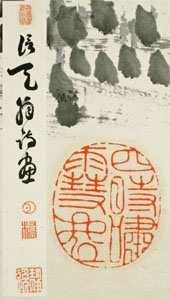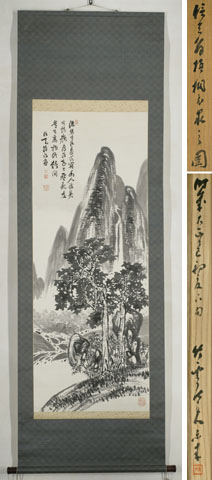Nanga
Landscape, The sound of the lute between the Paulownia’s and the bamboo.Signed: Shinten'ô taiga
Seals: Unread, Hashi, unread & Shijishô setsu ..
Technique: sumi on paper 135,7 x 52
Mounting: blue decorated silk fabric 209 x 66,4
Box: authenticated
Condition: fine
濃壁重陰自蔽關
幽人消暑坐怡顏
自為知己琴親友
常在高梧修竹間
Nôheki no jûin mizukara seki o ôi
yûjin shôsho suwarite kao o yorokobasu
mizukara chiki no koto o shin'yû to nashi
tsune ni kôgo shuchiku no aida ni aru.
In the deep shadow of the heavy wall I myself close the gate
(by being) a hermit I dispel the heath and sit down with a radiant face,
my trusty lute is like a good friend to me:
(its sound) lingers between the tall Paulownia’s and the bamboo.
Shinten'ô (Seiitsu) was one of the key figures in the Kyoto literati world.
He was born into a well-to-do and rather intellectual farming family near Nagoya. He studied calligraphy with Shinozaki Shôchiku (1781-1851), but as a painter he was mainly self-taught.
After his father’s death in 1848 he had to continue his studies at the local temple school. After the death of his younger brother his uncle sponsored his Confucian studies with Saitô Setsudô (1792-1865) for three years. Thereafter he studied Chinese literature with Yanagawa Seigan (1781-1859) and Umeda Unpin (1825-1865). With them he met with the royalists Rai Miisaburô and Fujimoto Tesseki (1817-1863) and they became friends. To avoid charges from the Bakufu he started to travel.
As a former member of the anti-Bakufu Imperial Loyalist movement, he received important governmental posts after the Meiji restoration, but, not yet fifty years old, he retired to devote his time to art and literati gatherings in his luxurious villa in Arashima.
Reference:
Addiss 1993
Kato ‘98 first chapter
Berry '01 p. 157-159
Hempel '98 pp. 169-170
Araki p. 1357
Price: ON REQUEST

